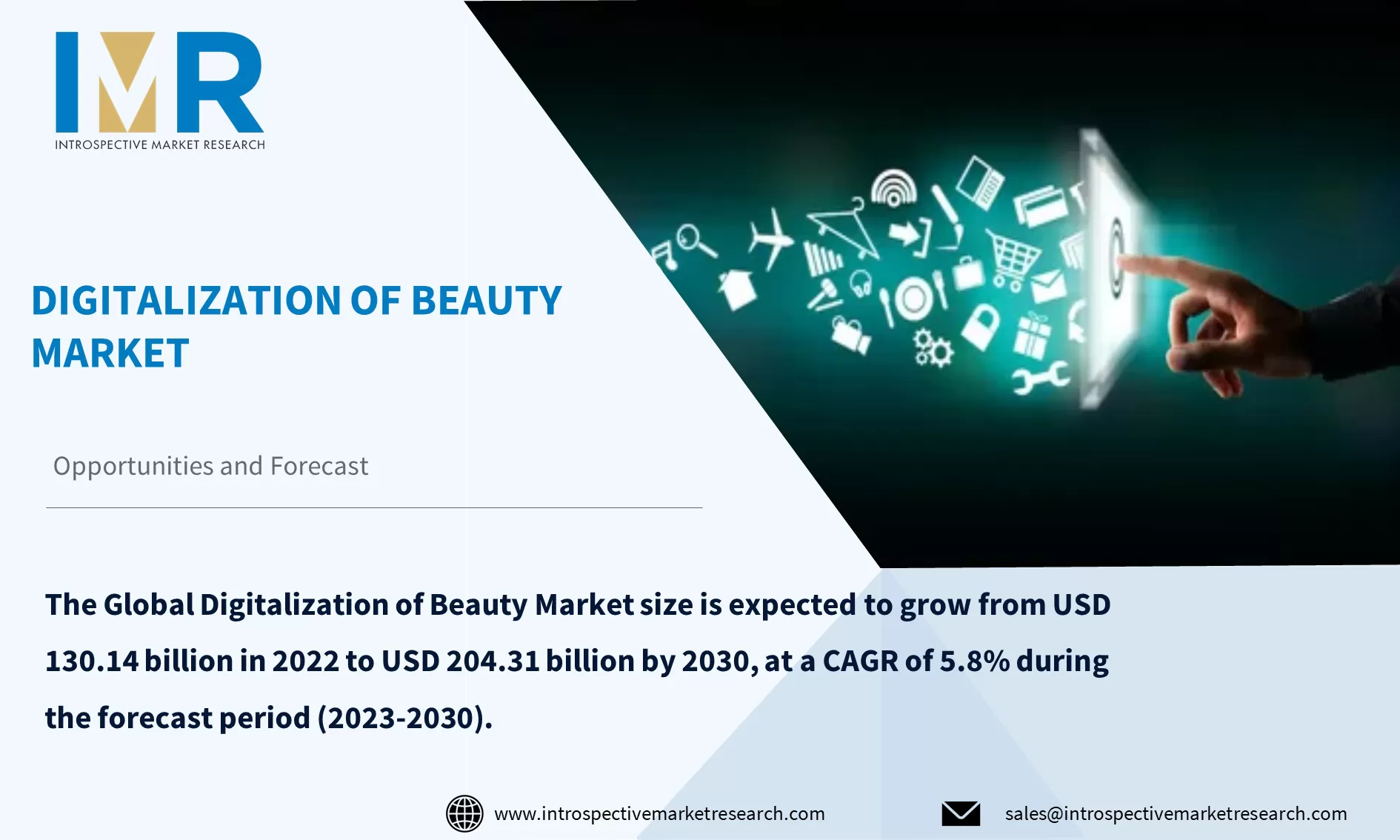
Market Overview:
The Global Digitalization of Beauty Market size is expected to grow from USD 130.14 billion in 2022 to USD 204.31 billion by 2030, at a CAGR of 5.8% during the forecast period (2023-2030).
The Digitalization of the Beauty industry is already one of the fastest-growing categories in the consumer goods industry. It is undergoing a digital transformation as social media and e-commerce. New widely available e-commerce technologies are enabling brands to directly reach their customers. The global cosmetics market is estimated to reach $675 billion by 2020. To analysts, Demand for the Digitalization of Beauty makeup is easing globally, especially in developed markets, following a strong hiring phase driven by increased social media and selfie adoption. Various brands are using new forms of emerging technology to personalize products and services. L'Or?al is helping customers look for the perfect foundation shade to match their skin tone with artificial intelligence (AI).
Top Key Players for Digitalization of Beauty Market:
Unilever, Procter & Gamble, Adimo, Amorepacific Corporation, CFEB Sisley SAS, Elizabeth Arden Inc., Johnson & Johnson, Lancer Skincare, L?Oreal S.A, Shiseido and other major players.
Market Dynamics and Factors for Digitalization of the Beauty Market:
Drivers:
Penetration of Smart Phones
The proliferation of smartphones has been a catalyst for the digitalization of the beauty market. These pocket-sized devices enable consumers to access beauty-related information, products, and services with unprecedented ease. Mobile apps provide virtual makeup try-ons, skincare analysis, and product recommendations, enhancing the online shopping experience. Social media platforms allow users to share beauty trends, reviews, and tutorials, fostering a sense of community and influencing purchasing decisions. Moreover, smartphones facilitate e-commerce transactions, making it convenient to shop for cosmetics and skincare products online. In essence, the widespread adoption of smartphones empowers consumers and fosters the growth of the digital beauty industry.
Opportunities:
Development in Technology to Personalize Products and Services
The advancement of technology, particularly in the realm of personalization, presents a significant opportunity for the global digitalization of the beauty market. With the use of AI-driven algorithms and data analytics, companies can tailor products and services to meet the specific needs and preferences of individual consumers. Customized skincare formulations, personalized makeup recommendations, and virtual beauty consultations are all made possible through these technological innovations. This not only enhances the consumer experience but also fosters brand loyalty and drives sales. By leveraging technology to offer highly personalized beauty solutions, the industry can tap into a lucrative market segment, propelling the digital beauty market to new heights.
Segmentation Analysis of the Digitalization of Beauty Market:
- By Type, The software segment is pivotal for the digitalization of the beauty market as it powers virtual try-on tools, skincare analysis algorithms, and mobile apps, providing consumers with personalized beauty experiences. This software-driven approach enhances engagement, fosters convenience, and drives the growth of the digital beauty industry.
- By Application, beauty companies are vital for the digitalization of the beauty market. It allows specialized brands to focus on niche audiences, catering to unique preferences and needs. This diversity encourages innovation and competition, driving the development of digital beauty technologies and enhancing consumer choices and experiences.
Regional Analysis of the Digitalization of Beauty Market:
The Digitalization of Beauty industry grew by almost 6% last year, with retail sales of about $320 billion. Beauty growth has been solid worldwide, and China is the key driver of the tremendous revenue it has seen over the past few years. Excluding China, the remaining four beauty countries are the United States, Japan, Brazil, and Germany, accounting for 36% of the Digitalization of Beauty market.
North America
- The U.S.
- Canada
- Mexico
Eastern Europe
- Russia
- Bulgaria
- The Czech Republic
- Hungary
- Poland
- Romania
- Rest of Eastern Europe
Western Europe
- Germany
- UK
- France
- Netherlands
- Italy
- Spain
- Rest of Western Europe
Asia Pacific
- China
- India
- Japan
- Singapore
- Australia
- New-Zealand
- Rest of APAC
Middle East & Africa
- Turkey
- Saudi Arabia
- Qatar
- UAE
- Israel
- South Africa
South America
- Brazil
- Argentina
- Rest of SA
Key Industry Development:
In January 2021, Perfect Corp., a beauty industry technology solution provider, recently secured $50 million in a Series C funding round, with Goldman Sachs leading the investment. This significant funding infusion highlights the growing interest in beauty tech innovations. Perfect Corp.'s AR and AI-driven solutions, including virtual makeup try-ons and skin analysis, are transforming the beauty industry by offering personalized, interactive experiences. This investment is expected to fuel further advancements in digital beauty technologies and expand the company's reach in the market.





